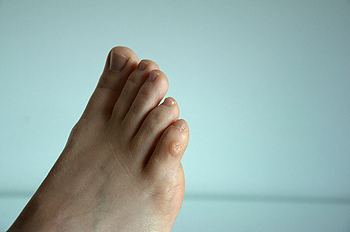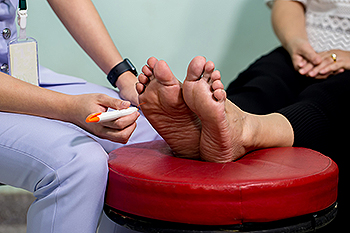
An ingrown toenail is the result of the nail growing into the skin instead of over it. This can happen from wearing shoes that are too tight or from trimming the toenails improperly. Some people will get an ingrown toenail from enduring a toe injury, or from inadequate foot hygiene. Additionally, there may be genetic factors that can cause an ingrown toenail to develop. Common symptoms that many patients experience can consist of the surrounding skin becoming red, swollen, and painful. If the nail becomes infected it may bleed and a discharge may ooze from the nail. A proper diagnosis is done by having a physical examination of the foot performed, and an X-ray may be necessary which can determine the extent of the injury. Mild relief may be found when the foot is soaked in warm water, thus making it easier to gently pull the skin away from the nail. This is considered to be a temporary solution and a podiatrist is eventually sought who can provide permanent relief, which may include surgery.
Ingrown toenails may initially present themselves as a minor discomfort, but they may progress into an infection in the skin without proper treatment. For more information about ingrown toenails, contact one of our podiatrists of Biebel & DeCotiis Podiatry Associates. Our doctors can provide the care you need to keep you pain-free and on your feet.
Ingrown Toenails
Ingrown toenails are caused when the corner or side of a toenail grows into the soft flesh surrounding it. They often result in redness, swelling, pain, and in some cases, infection. This condition typically affects the big toe and may recur if it is not treated properly.
Causes
- Improper toenail trimming
- Genetics
- Improper shoe fitting
- Injury from pedicures or nail picking
- Abnormal gait
- Poor hygiene
You are more likely to develop an ingrown toenail if you are obese, have diabetes, arthritis, or have any fungal infection in your nails. Additionally, people who have foot or toe deformities are at a higher risk of developing an ingrown toenail.
Symptoms
Some symptoms of ingrown toenails are redness, swelling, and pain. In rare cases, there may be a yellowish drainage coming from the nail.
Treatment
Ignoring an ingrown toenail can have serious complications. Infections of the nail border can progress to a deeper soft-tissue infection, which can then turn into a bone infection. You should always speak with your podiatrist if you suspect you have an ingrown toenail, especially if you have diabetes or poor circulation.
If you have any questions, please feel free to contact one of our offices located in Holmdel and Middletown, NJ . We offer the newest diagnostic and treatment technologies for all your foot care needs.









